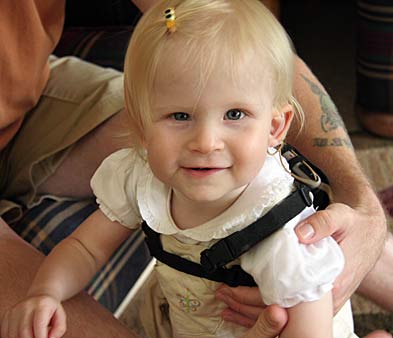
|
Rare procedure allows
babies born deaf to hear
Honolulu has only two doctors
who are capable of performing
the implant surgery
Fifteen-month-old Reina Larson likes to hear her dad whistling.
It's a sound the infant would never have heard except for a rare surgical procedure being done by only two doctors in Honolulu.
Support groups
|
"Now, a couple months later, she's making noises on her own, vocalizing certain sounds, and (she) responds," said her father, a Marine captain.
"She will turn when you call her name. It's a big difference. She can hear it and she can tell what direction it's coming from. It's very exciting."
Reina's surgery was done at Tripler Army Medical Center by Maj. (Dr.) Mitchell Ramsey, co-director of Tripler's cochlear (inner ear) implant program with audiology chief Amy Hines.
Dr. Lenhanh Tran, former Tripler pediatric ear, nose and throat specialist, established the CI program there in 2001, then went to Kapiolani Medical Center for Women and Children in 2003 and started a program.
All Hawaii newborns are screened for hearing so any problem can be diagnosed early. If the doctor determines that it isn't temporary, more testing is done and hearing aids are used as soon as possible so babies are aware of sound, Hines said.
"Anywhere from 10 percent of kids can have hearing loss," Ramsey said. "It is not an insignificant number."
The Food and Drug Administration has approved cochlear implant surgery for patients as young as one.
Cochlear implant users worldwide have grown to 60,000 from about 6,000 in 1994, but millions with severe to profound hearing loss could benefit from the device, Ramsey said.
The surgery hasn't been common in Hawaii largely because it hasn't been available, he said.
![]()

![]()
Maj. Mitchell Ramsey
"The success rate is high if the patient is a good candidate," she said. "Anatomically, the patient needs to have good inner ear integrity." Good family support also is essential for a child because a lot of rehabilitation is needed, she said.
Intensive training, especially for children, is necessary to help them connect sounds with meanings.
It's much easier for a child who has heard some speech to make those connections than for one who has never heard sounds, Tran said.
"But the younger you do it the better. They're still in a very early development stage and able to learn things faster."
The device has three pieces, which Reina has on at all times except when sleeping, her father said.
They include a tiny receiver coil implanted under the skin behind the ear with connecting electrodes on a wire threaded to the cochlea; an external headpiece with a microphone and wireless transmitter placed over the receiver coil and held in place by a weak magnet, and an external sound processor, worn on a belt or in a pocket, connected by a wire to the headpiece.
The Larsons, who also have a 4-year-old son, Stone, said no response was detected when Reina was tested for hearing at birth and results still were negative in a test a few months later.
Reina was signed up immediately for hearing aids, her father said. "And the option was given to us ... we could bring her up as a deaf child with sign language and that whole nine yards, or we could augment it ... We knew right away we wanted to get her implanted. There was no need for discussion between my wife and I."
![]()

![]()
Dr. Lenhanh Tran
But Reina "was very irritated by it," he said. "She would cry and scream. Sensory overload, I guess. ... It took about a day and a half so she could be comfortable with it and didn't cry."
Cochlear implants convert sounds into electrical signals that are transmitted to auditory nerve endings.
"The technology is extremely sophisticated," Ramsey said. "There is no other neuralogic organ that we've been able to mimic or replace."
However, Tran said, "The patient can get normal hearing ability but is still hearing-impaired."
Ramsey has performed 10 cochlear implants since joining Tripler in August 2002 after a two-year fellowship in the procedure at Harvard University.
He has four or five patients scheduled for implants in the next few months and he expects more in the future because of acoustic injuries to military personnel in Iraq.
Ramsey said the cost, totaling about $40,000 for the devices, surgery and hospital expenses, has been a big issue, but most medical insurance covers it.
Studies also have shown "it is a very cost-effective procedure compared to pacemakers, knee replacements and all kinds of things," he said.
Most kids who get cochlear implants are mainstreamed within a few years and they don't have special needs, which can cost up to $400,000 for 12 years of school, he said.
"The cost to society (of a cochlear implant) is actually less."
[News] [Business] [Features] [Sports] [Editorial] [Do It Electric!]
[Classified Ads] [Search] [Subscribe] [Info] [Letter to Editor]
[Feedback]
